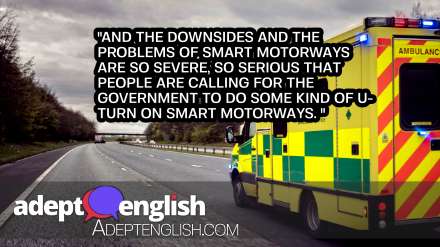Practice Listening To English Spoken By Native English Speakers
The last time we were talking about English spoken natively was about the UK shutting down, so it seems appropriate to practice listening to English about something involved in the UK opening up again.
It’s been a while since we talked about UK motorways, but with people starting to travel again in the UK we are all talking about traffic and roads and coffee conversations are sounding almost back to normal.
The UK has poor public transport. To get around most people just use cars. If you need to move between cities by car, you will most likely use a motorway. Which is why we’ve talked about motorways so much, we’ve talked about motorways in the news, motorways during the holidays, motorway spills, motorway slang and even covered it while talking about portmanteau.
So today we can practice listening to English spoken natively about a topic that you will hear in a lot of conversations (especially if you travel to work by car, which most of us do).
Most Unusual Words:
Motorways
Handbrake
Lockdown
Most common 4 word phrases:
| Phrase | Count |
|---|---|
| In A Live Lane | 3 |
| Motorways In The UK | 3 |
| I Did A Podcast | 2 |
| Roads In The UK | 2 |
| How To Use Them | 2 |
Listen To The Audio Lesson Now
The mp3 audio and pdf transcript for this lesson is now part of the Adept English back catalogue . You can still download and listen to this lesson as part of one of our podcast bundles.Transcript: Learn About UK Smart Motorways While Listening To English Spoken Natively
Hi and welcome to this podcast from Adept English. We are here to help you with your English. Spoken English improvement and fluency in English is our aim, our goal for you. But that’s best achieved through lots of listening to suitable, quality spoken English – just like our podcasts.
If you like our podcasts, but you want to go further and learn even more, then you can buy our Course One Activate Your Listening right now on our website at adeptenglish.com.
This will give you lots of practice, and more structure to your learning. And it will help you practice at spoken English conversation – you’ll hear other voices as well as mine. It’s a very popular course which helps you improve your spoken English and people write really good reviews about it!
Boost Your Learning With Adept English
Motorways in the UK
Now you may remember some time ago I did a podcast on Smart Motorways. Smart Motorways is the name of the scheme in the UK which has meant the so-called upgrading, the improvement if you like, of vast stretches of our motorways in the UK – so that they meet certain standards and so that they’re used in a different way.
Motorways are the fast roads in the UK – their signs are all blue. And if you’ve ever driven on UK roads, the motorways are prefixed with an M – the M3, the M4, the M42 for example. They’re like the Autobahn in German and the péage in France. Except that you don’t normally have to pay. There are tolls on a couple of sections – the M6 toll in the Midlands allows you to bypass the city of Birmingham, which is a blessing, a good thing. But mostly the cost of upkeep for Britain’s motorways comes out of the road tax that people pay on their vehicles, rather than from tolls.
Roads in the UK are super busy
So I did a podcast about Smart Motorways some time ago, partly because if you’re driving on those roads, you may not know immediately quite what the rules are or how to use them. And there are hefty fines – that means large amounts of money to pay, if you’re found speeding. ‘Speeding’ means going too fast – and it can be confusing on these motorways because the speed limit varies, it changes all the time, depending upon the traffic.
If you’ve ever driven on the motorways in the UK, you’ll know that we have traffic problems. One of the things which has been really nice about lockdown, is that there’s been so little traffic on the road. It’s getting back to normal now. And normal here, means inevitable traffic jams, pretty much whenever you go out on the motorway.
You would never for example choose to travel a long distance on a Friday afternoon or evening. It’s just not worth it, if you can avoid it – it means just hours and hours in the car and lots of frustration.
Video
A less costly way to solve the problem?
And it was the problem of congestion that prompted the government to come up with the idea of Smart Motorways and to invest in implementing the scheme. ‘To invest’ in something means to fund it, to put up the money for it. And if you ‘implement’ something, that means that you carry it out, you take the plan forward in practice.
So there was a period of time when lots of the motorways were being ‘upgraded’ to Smart Motorway and this, and the fact that many people didn’t know how to use them, was what prompted me to write the first podcast on this subject in 2018. The chance of being caught speeding on these motorways is much higher and there are stiff penalties – you have to pay a large fine, if the cameras catch you – so hopefully that was useful information at the time.
Are Smart Motorways a good idea?
So, why am I speaking about them again? The answer is that some of the statistics for Smart Motorways are now out – and they make startling reading. Instead of Smart Motorways being a largely good scheme which eases congestion, there are some alarming facts and anecdotes coming to light.
An ‘anecdote’, A-N-E-C-D-O-T-E means a story, something that people tell from their personal experience. And ‘coming to light’ means being discovered, becoming evident. And the downsides and the problems of Smart Motorways are so severe, so serious that people are calling for the government to do some kind of U-turn on Smart Motorways. A ‘U-turn’ is where you stop going in one direction, you turn 180 degrees and you start going in the opposite direction. It happens in politics quite a lot, U-turning!
📷
A photograph of a UK motorway hard shoulder with an ambulance. Used in this English listening practice lesson.
The whereabouts of the ‘Stopped Vehicle Detection System’?
So what are the problems? Well, if you remember, the idea of a Smart Motorway is that you take the hard shoulder and use it as a lane. The ‘hard shoulder’ is the name of the lane at the edge of the road. Normally you wouldn’t drive on the hard shoulder – it’s there to park in, if your car breaks down, if you have a flat tyre. So taking this lane for traffic seemed like a quick win.
An extra lane to ease congestion, without the huge cost of widening the road. Smart Motorways still cost a huge amount of money, but just not quite so much as widening the road. So OK, but what if you do breakdown on a Smart Motorway? What if you do have a flat tyre? Well, what’s supposed to happen is that there are overhead signs – and an X or a cross in that lane means that it’s illegal to drive in that lane – you can be fined quite a lot of money if you make that mistake. So this is supposed to make it safe, when someone breaks down.
OK, but how does that X arrive in the sign above the lane – so that anyone who’s broken down is safe, while they’re parked there.
And therein lies the problem. The technology which is supposed to detect, to see any broken down vehicles – well actually that only exists for one section of the M25. The M25 is the circular motorway, which goes around London.
So what about the rest of the Smart Motorway sections of road? Well, the answer is that you’ve got to wait for a human being to notice that there’s a problem, before the signs with the Xs, showing the lane is blocked – before these are switched on. The plan was to roll out the ‘stopped vehicle detection system’ – that’s the automated system - to every Smart Motorway. But currently only 25 miles out of 400 miles of Smart Motorway are covered by this system. Well that was at January 2020. So mostly, there is no detection system.
Your life in your hands
So while you’re waiting to be rescued, you’re sitting in a ‘live lane’ – that’s a lane of traffic moving towards you at 70mph and above – from behind. And you’re waiting for someone to notice you on the cameras – and hoping that cars don’t hit you from behind. Often there’s a grass verge, that’s V-E-R-G-E – the grassy bit at the side of the road. But the trouble is – and I’ve noticed this myself – there is usually a crash barrier at the side of the road. So that’s a strip of metal that’s intended to stop you driving off the carriageway, driving off the road.
So you can’t get out of the way, it’s impossible even to park on the grass verge. And if you breakdown in the middle lane or the outside lane of the motorway, you’ve no possibility of waiting safely. The AA or the Automobile Association in the UK, reports that on average it takes 17 minutes for a human being to notice on the camera that you’re stopped – and then a further 17 minutes to get help to you. So that’s an average of 34 minutes, sitting in a live lane, with cars coming up behind you at 70mph, and half of that time, there’s no warning to other drivers at all.
Stats on Smart Motorway safety in the UK
So what are the statistics on this? Well, one report this year said that over 19,000 drivers had been stranded in a live lane in the last two years. There have been 38 deaths altogether, with four people killed on one section of the M1 in just 10 months.
And the number of ‘near miss’ incidents apparently rose by 20 times on some sections of road. Highways England are the government’s road management company and Highways England’s advice – ‘Check your car before you set off’. Mmmm – that doesn’t seem very satisfactory to me. You can’t always anticipate these problems - even new cars break down. And that rather puts the onus of safety on the driver, doesn’t it?
How to be safe on Britain’s Smart Motorways?
The plan is to increase the number of what are called ‘refuge areas’. ‘Refuge’, R-E-F-U-G-E means a place of safety, as in the word ‘refugee’. So there are little parking areas at the side of the motorway, but currently most of them are 1.5 miles apart. The government recommendation is that these refuges should be positioned every half mile. And of course, in the first safety trial, the first safety test of Smart Motorway in 2006, all of the cameras were working – and the refuge areas were every 500 metres, not every 1.5 miles, which was what actually was rolled out, what was done. So of course the trial was safe. It’s just not the reality on large sections of our motorway.
Download The Podcast Audio & Transcript
In the meantime, the advice? Well, they say to stay in the car and dial 999 for the police. The AA, the Automobile Association doesn’t necessarily come out for these calls – they say ‘It’s too dangerous’ for their workers, for their crew. Great! I would have thought that if you’re in the lane at the side of the road, you’d be safer getting out of the car, climbing over the crash barrier and standing at a distance from the motorway.
That’s what I’d do with my family anyway, but it’s not the official advice. And if you’re in the middle lane or the outside lane and you can’t get to the side of the road? Well, do you sit with your car out of gear and your handbrake off? And then if someone does hit you, you get a big jolt, but your car will be pushed forward and isn’t absorbing the full impact. I don’t know – it seems to be left up to us to decide. And they’re desperate measures!
Goodbye
So if you’re driving on UK Smart Motorways, take care – and be aware. And if you have Smart Motorways or their equivalent in your country, have a look at safety statistics, then you‘re aware of any danger. So that’s today’s lesson in understanding English. Spoken English for you to practice with. So listen to today’s spoken English material a number of times – repeat listening really is key. And stay safe on the road.
Enough for now. Have a lovely day. Speak to you again soon. Goodbye.










